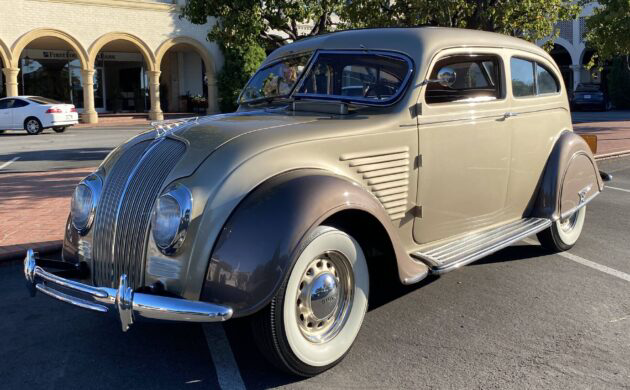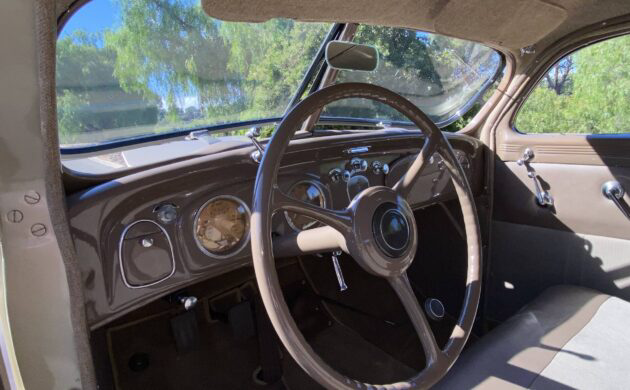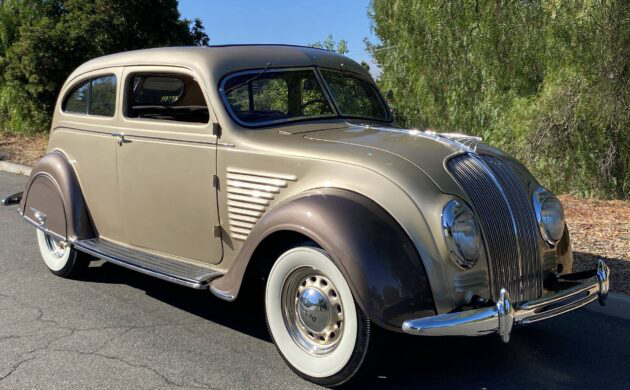The automotive design and manufacturing world is complex, but the recipe for sales success is relatively simple. A company must take sound engineering and construction techniques, wrap them in a body that people find attractive, and market those vehicles at an appropriate price. However, the pathway to creating a sales lemon is far more complex. Chrysler discovered that with its Airflow models from the 1930s. The styling didn’t gel with potential buyers, and the Corporation ended the program after only four years. Our feature car is a 1934 DeSoto Airflow Brougham. It is beautifully restored and is one of the rarest vehicles to emerge from that company. It is one of only four known to still exist and should appeal to an enthusiast seeking something distinctive that will turn heads. The DeSoto is listed here at Barn Finds Classifieds in Palos Verdes, California.
If you assess the styling of early passenger cars, it is easy to see how they earned the label “horseless carriages.” The upright styling and exposed headlamps were reminiscent of their horse-drawn counterparts, and most possessed the aerodynamic efficiency of a barn…traveling sideways. The situation evolved and improved during the 1920s, but most new cars retained many of their upright design features. Chrysler conceived an alternative to improve the situation by introducing a model focusing on a more streamlined and efficient appearance. The Airflow appeared in 1934, and its styling was unlike anything that came before it. The curved nose housed integrated headlamps, the fenders swept in majestic curves, and the rear skirts accentuated the aerodynamic focus. Unfortunately, it proved too radical for potential customers, and despite ongoing styling updates, the last Chrysler Airflow rolled off the line in 1937. In the spirit of badge engineering, DeSoto added an Airflow variant to its model lineup in 1934. It carried the same design cues but with subtle trim and badging variations. Our feature car is a rare two-door Brougham. It was produced in 1934 and has undergone a meticulous restoration to return it to its former glory. Its two-tone Medium Brown and Light Tan Metallic paint looks flawless, shining magnificently under the Californian sun. The panels are laser-straight, and there isn’t a spot of rust or corrosion anywhere. The rear fender skirts make the car sleeker, and the chrome is immaculate. The glass is crystal clear, and this classic will undoubtedly turn heads wherever it goes.
The theme of spotless presentation continues inside this DeSoto, with the car looking like it would have the day the original owner took delivery. The upholstered surfaces were retrimmed in Tan cloth and Brown vinyl, with the restorer faithfully following the original seams and patterns. There is no evidence of wear or other issues, while a set of practical floor mats protects the Tan carpet. The painted surfaces shine as impressively as the exterior, and the wheel is in as-new condition. The bright trim appears perfect, the gauges are crystal clear, and there are no aftermarket additions. Air conditioning was unheard of in passenger cars from this era, but this DeSoto’s modified crank-out windshield provides flow-through ventilation, making that luxury unnecessary. One interesting side-effect of the styling was that it made the passenger compartment significantly wider than most expected from a vehicle of this type. That allowed for comfortable three-abreast seating, allowing the Airflow to accommodate six people comfortably.
The Airflow’s styling might have been radical, but its mechanical configuration was typical of the era. That swooping hood hides a 241.5ci flathead six-cylinder powerplant producing 100hp and 185 t/lbs of torque. That power feeds to the rear wheels via a three-speed manual transmission with a floor-mounted shifter. The drivetrain wasn’t radical, but the DeSoto received almost universal praise from motoring journalists. They were impressed by the additional interior space provided by the unique styling, the car’s performance, and its exceptional fuel economy. The owner recently treated that flathead to a rebuild. The process included fabricating a new aluminum head, balancing everything, and adding a six-blade fan and electric fuel pump to enhance reliability. The transmission was serviced then, and everything functions as it should. The engine roars into life easily, the transmission shifts smoothly, and the clutch works perfectly. Potential buyers should consider this a turnkey classic.
The Airflow experiment wasn’t the success that Chrysler had envisaged. Automotive history is full of examples of manufacturers following a bold and radical plan, only for their cars to be rejected in the market. Sadly, this model line undeservedly joined that list. DeSoto produced 522 examples of the Airflow 2-Door Brougham in 1934, and only four are known to exist. That makes this a rare Mopar classic and one that deserves to be preserved. Are you willing to do that?






It’s quite beautiful. To me it was the right car at the wrong time. I can think of another car that had the same problem. The Tucker. Praise to the seller for such a beautiful restoration. This needs to be on exhibit for many to appreciate.
I’ve always liked the airflow design since I was a kid.I’d love to take a ride in this one it would be a treat.There has to be 100k in this car. Wonder what the history is of it and why they had to fabricate a new head which is amazing.If it could only talk I bet it’s fascinating. glwts.
The main issue with aluminum heads in the mid-1930s was the lack of suitable anti-freeze. The internal water passages for the cooling system would corrode terribly and anti-freeze was needed to keep corrosion down to a minimum. For geographical areas where the temps never went below the freezing point, as the alloy head equipped cars became cheap used cars, owners just used plain water.
Years ago I found a pair of Packard 12 aluminum heads at Hershey, both had multiple holes in the outer surfaces of the heads from severe corrosion, as the car had been left in a shed with plain water in the cooling system.
I can imagine how difficult it might be today to find a useable alloy head for a 1934 DeSoto.
galvanic reaction between iron and aluminum too.did lots of 307 olds and small block chevy intake gaskets in the late 80’s early 90’s with aluminum intakes.But you are right .Oil and anti freeze quality have come a long way now if they (government) would get that alcohol out of gasoline that would be great.
Maggy,
Your comment mentioning head gaskets reminded me of the need to use special head gaskets for alloy heads. One of the worst things one can do is use a head gasket with copper to seal an alloy head, as the galvanic action will ruin the head very quickly.
I had a 1950s car in my shop that kept overheating. It had an alloy head, and during the engine’s restoration, the owner had substituted a copper head gasket instead of the special steel gasket. The gasket caused massive corrosion to the point it clogged the radiator with the tiny flakes of aluminum.
I worked in the engineering department of a major engine gasket manufacturing company for several years. Bimetalic engines (aluminum head, iron block) need thicker multilayer head gaskets for sealing because the aluminum and iron expand at different rates during engine warm up. So even with the head torqued down to specification, there is movement and the gasket needs to keep the engine sealed during those cycles. Over the long term, these repeated cycles and exposure to heat from the engine can cause the gasket material to become brittle and fail. Engines with the head and block made from the same metal use thinner gaskets and the engines typically last longer.
Seller here…A gentleman in the Airflow Club found someone to fabricate aluminum heads as exact replicas, with all the correct stamping, etc.
The Airflow story is as fascinating as the cars themselves. It wasn’t just the styling that was different; the all-steel construction was new, also. The combination of all-new styling and all-new construction methods led to production delays, which the competition seized upon and painted the Airflows as underdeveloped and unsafe. Quality control issues in early cars did nothing to dispel the rumors. Even pushing a car off a cliff and driving off afterward didn’t help. By the time Chrysler had all the issues resolved, the damage was done, and the Airflow was a flop.
My uncle restored a 1936 Airflow, turned out to be a beautiful automobile.
A museum piece and far more unique than a hemi Cuda. If I had deep pockets, this is one I would have.
A truly lovely 1934 DeSoto Airflow Brougham, in superb condition – apparently concours. Definitely one of the most iconic Airflows in existence and worthy of a serious collector or a major museum like the Petersen. My very first car was a 1957 DeSoto Adventurer in metallic gold. This example is trememdously impressive, and good luck to both the seller and the buyer!
I’d love to see the dollar sign attached. What an impressive display!
Now I know where the Germans got the idea for the Volkswagen from.
Not really. Much closer to home was the car company in Czechoslovakia known as Tatra. Their 1934 T-77A was far more streamlined than the Airflow. The engineer at Tatra was Hans Ledwinka, who ended up working with Ferdinand Porsche during the war. Many of the supposedly unique aspects of the VW and Porsche cars actually came from Ledwinka.
If you take a look at the very 1st Toyotas they look like a copy of the Airflow. I don’t think that they used the Airflows more advanced construction methods, but outward appearance is near identical. I think it even had a flathead 6. I read a article on the very 1st Toyota ever made that was rediscovered in Siberia, taken after WWII as war loot. It now resides in Toyota’s museum in it’s as found condition.
This 2019 article on the car contains two pre-restoration photos of the car. (near the end of the article)
https://autorestorer.com/articles/1934_desoto_airflow-572
This car has been for sale for some time. I’m thinking at least a year or two as I recall seeing it on CL some time back. Cool car, but very limited market especially with the $150k price tag.
Seller here…. We have owned this car for nearly 15 years and it has only been listed for sale about a week. Let me know if you have any questions. Thanks!
one ugly car
To each his own. I think the 1930’s produced some of the most beautiful cars and this is one of them.
One beautiful car. Just look at the lines of the body and the way the fenders flow with the style of the body. The grille area and headlights are really cool looking. The color combination makes this car look expensive.
There is one of these two door models here in Temuka in New Zealand.
If Divco made a sedan
@ Andrew:
Back in the late ’60s I would occasionally visit Temuka (from In’gill) and I used to sometimes stay with a family by the last name of “Wall.”
Even then, the family’s daily-driver was a 1938 2-door Ford sedan (if I recall the model year correctly) and Mr. Wall used to tell me stories of all kinds of American cars from the 1930 to 1940 era that were still being used as daily transport in and around Temuka. Possibly the car to which you refer could have been one of them from back in the day?
Hello, I am the seller of this Airflow. Please go here for full description and to make an offer:
https://www.hemmings.com/listing/1934-desoto-airflow-palos-verdes-ca-276838
Thank you!